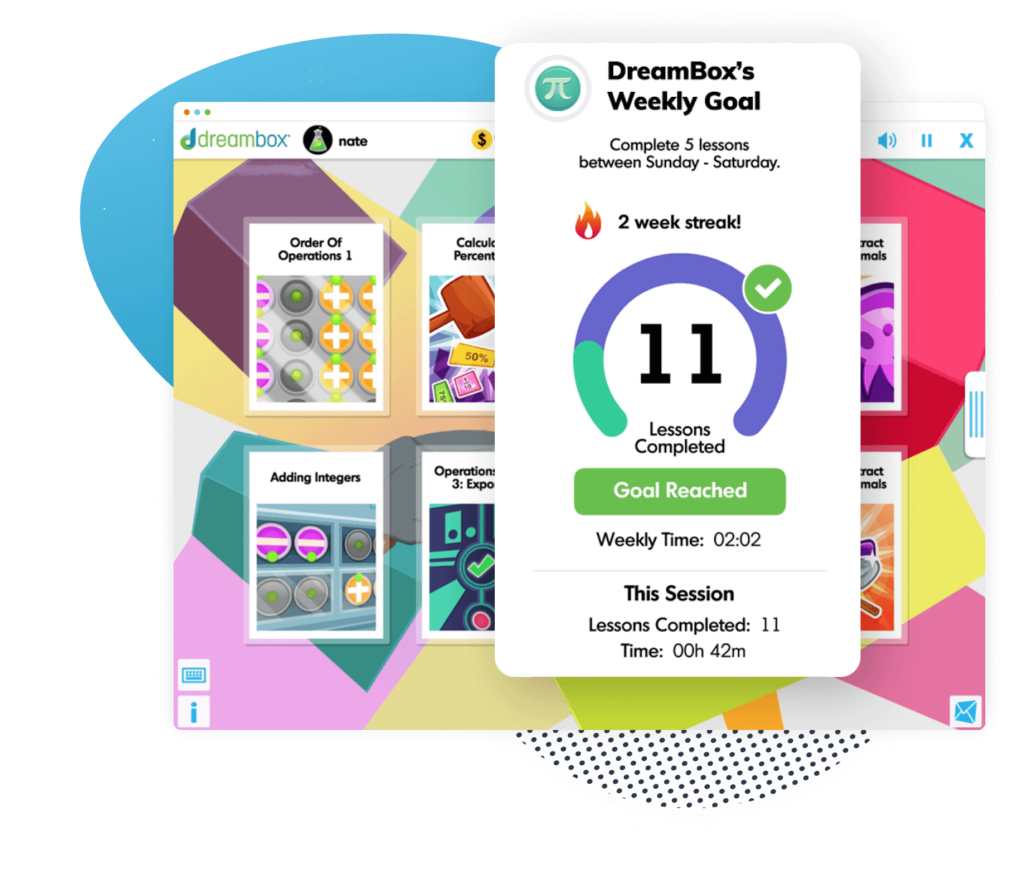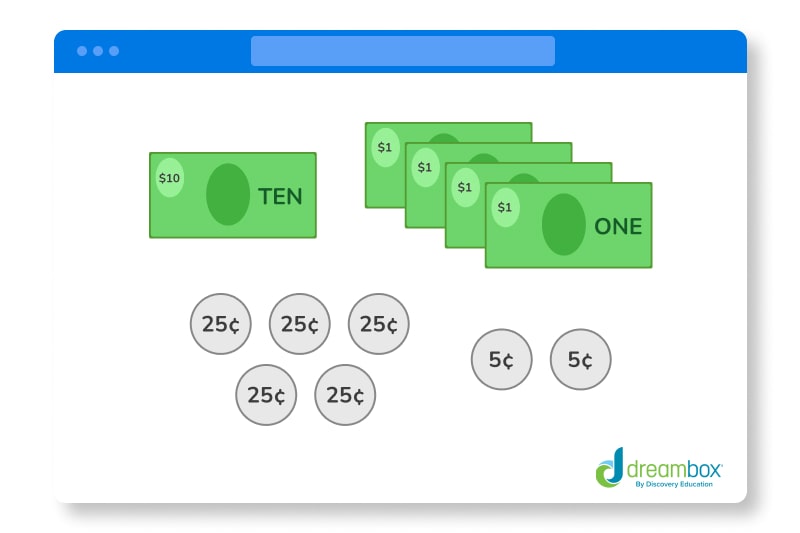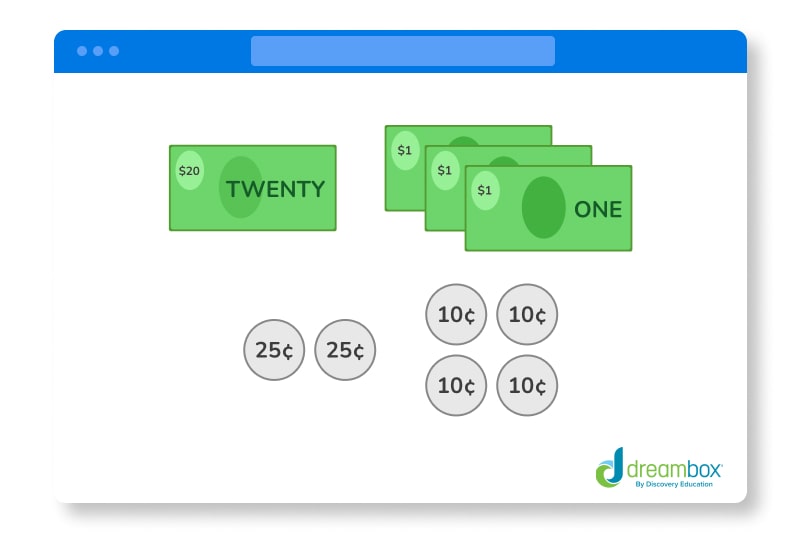Money problems for 2nd grade
Let’s learn why money word problems are an important part of 2nd-grade math and explore strategies to help students build confidence handling money in the real world.

Author
Katie Wickliff
Published:
July 2025
Key takeaways
- • The ability to understand and work with money is an essential life skill.
- • Students should build strong money sense early in elementary school.
- • Purposeful instructions and strategies help students feel more confident about money.
“But when will I ever use this in real life?”
This complaint is likely familiar to many parents and teachers. Students often doubt whether they’ll use math concepts in the future, and sometimes they have a point. Depending on the student’s individual path, they might not use every skill they learned in math. One concept they’ll definitely use in everyday life? Learning how to understand and work with money. This article focuses on money word problems for 2nd graders. We’ll explore why money problems are an important part of 2nd grade math, outline simple strategies for solving them, and highlight teaching methods that build students’ confidence when working with money. We also include several examples of money word problems to use with your own child or group of students.
What are money word problems?
Money word problems are math questions that present everyday scenarios that involve coins and bills, such as buying food at a grocery store, making change, or comparing prices. These word problems help students practice using the four operations: addition, subtraction, multiplication, and division, and allow them to connect math skills to everyday situations they can understand. For 2nd graders, money word problems are important because they take abstract concepts and connect them to something meaningful.
Why money word problems matter in 2nd grade
Solving word problems in elementary school is an essential part of math. It helps young students see the connection between the classroom and the real world. Money word problems are especially important for 2nd graders because being able to work with money is a skill every person needs, no matter where they live or what career they have.
Money math problems help develop essential skills that 2nd graders need, such as numeracy, problem solving, and financial literacy.
- Numeracy is the ability to understand and apply math to everyday life. Money math problems help students build numeracy because they provide a concrete way for students to visualize and work with numbers. For example, imagine that students are asked to solve the following problem: a child wants to buy a sandwich for $3.50 and a cookie for $1.25. They have a $5 bill, and they need to figure out if they have enough money to pay for the food. To solve this problem, students need to use addition, place value, decimal knowledge, and subtraction. They also need to compare numbers to determine if the total cost is less than, equal to, or greater than $5.
- Problem-solving is an essential skill in math and beyond. Money word problems encourage kids to think critically, make logical decisions, and develop confidence.
- Financial literacy is the ability to understand and manage money– how to earn it, save it, spend it, and share it. Setting the foundation for these skills from a young age helps kids learn to make smart money decisions throughout their lives.
Table of contents
Get more practice with second grade math with DreamBox!
How to solve money word problems
When 2nd graders begin working with money, following clear and consistent instructions helps ease the frustration that often comes with learning a new skill. Here is a step-by-step strategy kids can use to solve money word problems.
First, students should read (or listen to) the problem carefully and note important details, like item prices or overall budget, and understand what the problem is asking them to do. Next, they’ll need to identify the operations they’ll need to solve the problem. For example, are they adding numbers together, subtracting to make change, comparing prices, or all three? Then, 2nd graders should use pencil and paper or manipulatives to set up the problem and solve. Finally, students should check the answer. In my experience, this last step is often the hardest– students just want to be done with the problem! Encourage them to slow down here and make sure their hard work is correct.
Teaching strategies for solving money word problems
While there are several effective strategies for teaching 2nd grade word problems, visual aids or hands on materials are particularly effective for elementary students.
- Visual aids like colorful pictures that show the names and values of different bills and coins help make money problems easier to understand. Using number lines is a great way to help students count up or down to make change, and restaurant“menus” that look like the real thing help students practice using money in real world scenarios.
- Manipulatives are physical objects that make abstract math concepts more concrete. Students can use play money to group coins or bills and add and subtract.
- Emphasizing real life scenarios, such as pretend shopping, is a great way to make learning about money fun. When my son was in first grade, the students earned play money throughout the week for different reasons– being respectful, cleaning up quietly, or helping a friend. At the end of the week, they counted their money and got to “shop” for a reward. The more money they had, the more valuable the prize.
Giving students plenty of opportunities to practice solving money word problems is key to building competence and confidence! For more practice opportunities, check out Dreambox Math. This interactive math program is tailored to your child’s unique needs and will help students develop these skills.

The math program that drives results
Get started today!
DreamBox adapts to your child’s level and learning needs, ensuring they are appropriately challenged and get confidence-building wins.
20 2nd grade money word problems
1. Jonah has 2 quarters, 5 dimes, and 3 nickels. He wants to buy gummy candy that costs $1.25. Does Jonah have enough money?
Answer
2. Claire buys a box of markers that costs $2.15. If she pays with 6 quarters and 12 dimes, how much change does Claire get back?
Answer
Claire gets 55¢ back.
(6 quarters = $1.50, 12 dimes = $1.20, so $1.50 + $1.20 = $2.70 total paid. $2.70 – $2.15 = 55¢ change)
3. One large cheese pizza costs $18.50, and one liter of soda costs $5.20. If Mr. Lee’s class has $25.00, do they have enough money for the pizza and soda?
Answer
Yes. They need $23.70, and they have $25.00.
(Pizza $18.50 + soda $5.20 = $23.70 total needed. Since they have $25.00, which is more than $23.70, they have enough money.)
4. Connor has $34.00 in savings and wants to buy two video games that cost $18.00 apiece. Does Connor have enough money for both games?
Answer
5. Esmat dumps out his piggy bank. Here are his bills and coins:

Answer
Esmat has $15.35.
(One $10 bill + four $1 bills + 5 quarters + 2 nickels = $10.00 + $4.00 + $1.25 + $0.10 = $15.35)
6. If Molly has eight dollars and forty-four cents, how do you write that in dollars and cents?
Eight dollars and forty-four cents = ____________________
Answer
7. Kelvin buys 3 baseballs for $2.00 apiece and 1 baseball bat for $15.00. How much does he spend in total, and how much more money would he need if he only had $11.00?
Answer
Kelvin spends $21.00 in total. If he only had $11.00, he would need $10.00 more.
(3 baseballs at $2.00 each = $6.00, plus 1 bat for $15.00 = $21.00 total. If he only had $11.00, he would need $21.00 – $11.00 = $10.00 more.)
8. David buys a sandwich for $4.75 and a bag of chips for $1.50. If he pays with a ten-dollar bill, how much change does David get back?
Answer
David gets $3.75 back.
($4.75 + $1.50 = $6.25 total cost. $10.00 – $6.25 = $3.75 change)
9. Leo wants to buy a toy robot for $13.60 and batteries for $2.85. He has two five-dollar bills, four quarters, and six dimes. Does Leo have enough money for both items?
Answer
10. Naomi empties her wallet and finds these bills and coins:

Answer
Naomi has $23.90.
(One $20 bill + three $1 bills + 2 quarters + 4 dimes = $20.00 + $3.00 + $0.50 + $0.40 = $23.90)
Take at home math practice to the next level
Empowering parents and educators to make math practice more impactful. Plus, your kids will love it.

11. If Jordan has three dollars and forty-five cents, how do you write that in dollars and cents?
Three dollars and forty-five cents = ____________________
Answer
$3.45
12. Ella counts her coins and finds 10 nickels, 8 dimes, and 4 quarters. She wants to buy stickers that cost $2.25. Does Ella have enough money?
Answer
Yes. Ella has $2.30, which is enough money.
(10 nickels = 50¢, 8 dimes = 80¢, 4 quarters = $1.00, so 50¢ + 80¢ + $1.00 = $2.30, which is more than the $2.25 needed for stickers.)
13. Ben buys 2 books for $3.15 each and 1 poster for $4.25. How much does he spend in total, and how much change would he get from a twenty-dollar bill?
Answer
Ben spends $10.55 in total. He would get $9.45 change from a twenty-dollar bill.
(2 books at $3.15 each = $6.30, plus 1 poster for $4.25 = $10.55 total. $20.00 – $10.55 = $9.45 change.)
14. One movie ticket costs $8.50, and one box of candy costs $3.75. If Lily has $15.00, does she have enough money for the ticket and candy?
Answer
Yes. She has $15.00 and only needs $12.25.
(Movie ticket $8.50 + candy $3.75 = $12.25 total needed. Since Lily has $15.00, which is more than $12.25, she has enough money.)
15. Owen has $20.00 in his savings account and wants to buy three action figures that cost $7.33 per piece. Does Owen have enough money for all three figures?
Answer
No. The figures cost $21.99 in total, and Owen only has $20.00.
(3 action figures at $7.33 each = $21.99 total. Since Owen only has $20.00, which is less than $21.99, he doesn’t have enough money.)
16. Rachel finds coins in her car seat cushions. If she has 3 quarters, 10 dimes, and 2 nickels, how much money did she find?
Answer
Rachel found $1.85.
(3 quarters = $0.75, 10 dimes = $1.00, 2 nickels = $0.10, so $0.75 + $1.00 + $0.10 = $1.85.)
17. Chris buys a train ticket that costs $17.25. If he pays with a ten-dollar bill, a five-dollar bill, and 5 one-dollar bills, how much change does Chris get back?
Answer
Chris gets $2.75 back.
(One $10 bill + one $5 bill + five $1 bills = $10.00 + $5.00 + $5.00 = $20.00 total paid. $20.00 – $17.25 = $2.75 change.)
18. Carlos wants to buy two notebooks that cost $2.35 each and a pack of pens for $3.80. How much will everything cost together, and how much more money would he need if he only had $8.00?
Answer
Carlos needs $8.50 total. If he only had $8.00, he would need 50¢ more.
(2 notebooks at $2.35 each = $4.70, plus pens for $3.80 = $8.50 total. If he only had $8.00, he would need $8.50 – $8.00 = 50¢ more.)
19. One art kit costs $6.80, and one set of colored pencils costs $3.40. If Samantha’s class has $12.00, do they have enough money for the art kit and pencils?
Answer
Yes. They need $10.20, and they have $12.00.
(Art kit $6.80 + colored pencils $3.40 = $10.20 total needed. Since they have $12.00, which is more than $10.20, they have enough money.)
20. CHALLENGE: Mrs. Rodriguez takes her three children to the school fair. She has a twenty-dollar bill, two five-dollar bills, 8 quarters, and 6 dimes in her purse. Each child wants a wristband that costs $3.75, cotton candy for $2.25, and a small toy from the prize booth for $4.50. Does Mrs. Rodriguez have enough money for all three children, and if so, how much money will she have left over?
Answer
FAQs
For 2nd graders, money problems should involve real world scenarios that are meaningful to young students, such as buying snacks, counting allowance, or comparing prices on a menu. Problems should help kids practice addition, subtraction, and multiplication (or repeated addition), and should keep numbers manageable, usually less than $50, to build confidence.
You can make money word problems more engaging by using plenty of visual aids, manipulatives, and pretend scenarios. Making math fun through games and activities helps students feel more engaged, motivated, and confident.
Common mistakes students make with money problems often come with a lack of experience with money in the real world. Many students struggle to remember the values of coins and bills because of their different sizes– for example, thinking a dime is less than a nickel because the coin is smaller. Some students also have trouble determining what a word problem is asking them to solve and what steps to use. With strategic instruction and plenty of hands-on practice, students will begin to solve money word problems accurately and consistently.

About the Author
Katie Wickliff
Katie holds a master’s degree in Education, has over 15 years of education experience as a primary classroom teacher, and is Orton-Gillingham certified tutor. Most importantly, Katie is the mother of two primary school students, ages 8 and 11. She is passionate about maths education and firmly believes that the right tools and support will help every student reach their full potential.